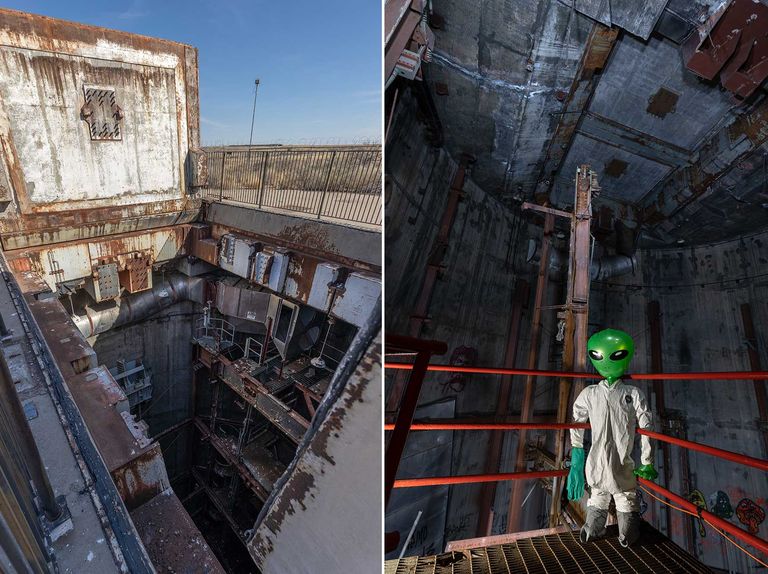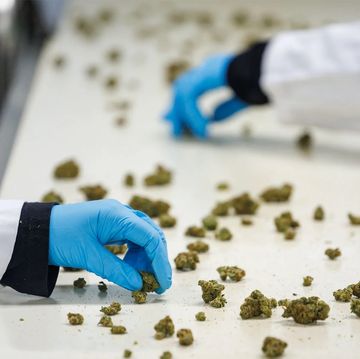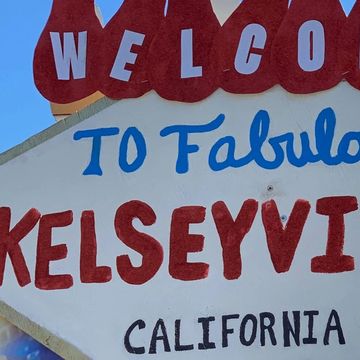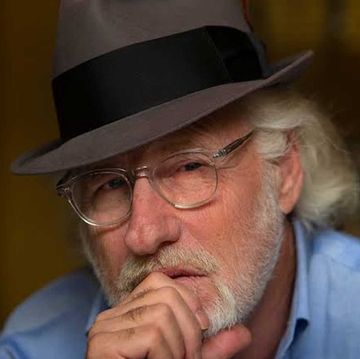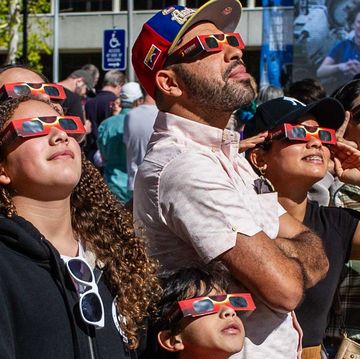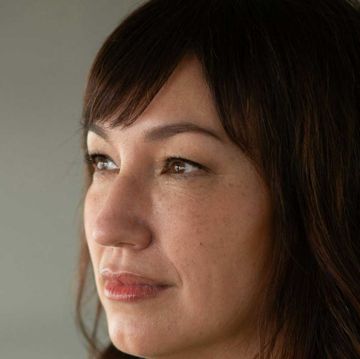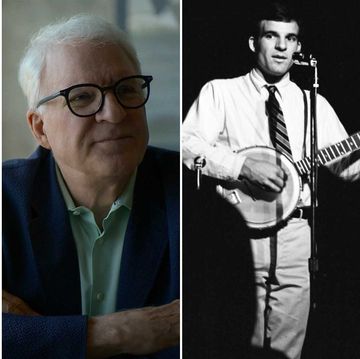I’m crouched on a rusted girder, 150 feet beneath the desert of New Mexico, near the bottom of a 52-foot-wide concrete hole. Above me, at the surface, a pair of huge, 45-ton doors are open to the bright spring day. Rust and decay surround me—flaking steel, owl pellets, shredded insulation, a dead rat. The bottom of this empty shaft smells faintly of dust and old chemicals, and of history, too: for a few short years in the early 1960s, an 82-foot Atlas F intercontinental ballistic missile stood here, one of 72 such weapons scattered across the United States, each carrying a warhead 300 times as powerful as the one that flattened Hiroshima in 1945.
After being decommissioned in 1965, silos like these were stripped almost bare, their equipment repurposed, and the sites themselves sold to the public. But when they were operational, they were considered the nation’s insurance policy against attack. “We could take a one-megaton hit within a mile and still launch our missile,” says Gary Baker. He owns Site 10, the silo I’m currently exploring, and Site 4, where I’m planning to spend the night. I won’t be sleeping amid rodent carcasses and twisted steel, though. Baker has converted the launch control center at Site 4 into two levels of living space. Downstairs is an apartment, where he and his wife, Eva, live with her cousin Raúl Bernal. Upstairs is that most modern of shelters—an Airbnb.
BUNKER MENTALITY
Earlier that day, a string of telephone poles are the tallest things I pass while driving east from Roswell, about 20 miles away. You can’t swing a dead extraterrestrial around here without hitting a reminder of the UFO that supposedly crashed nearby in 1947. There are flying saucer pictures and signs everywhere and little green men at gas stations and outside pecan orchards. As I pull onto a dirt track just off the highway, I spot oil derricks at the northwestern edge of the Permian Basin and smell raw petroleum in the air. Not a bird or an insect calls. An American flag flaps in the constant wind.
When I arrive at Site 4, the silo’s doors are closed. Close by, a low triangular structure seems to disappear into the earth. Bernal opens its steel door; a concrete staircase leads underground. He escorts me past framed photographs of missile sites in various stages of construction. Two stories below the desert, we face a two-ton blast door that protects the former control center. Behind us, at the end of a 100-foot tunnel broken up by more blast doors, stands the empty silo, an immense vertical tube lit by floodlights.
Like the silo, the control center is a concrete cylinder, this one 44 feet across. Inside the Airbnb, the concrete is obscured by drywall and wooden partitions, the walls and wainscot done in military browns and tans. A fire-engine-red refrigerator marks the open kitchenette, which stands on one side of a sitting room anchored by a central concrete pillar. The space wants to feel roomy, but something is missing. Off a short entryway are a utility closet, a bathroom, and a small bedroom with a walk-in closet. Behind a scrim wall, a washer and dryer crouch in the dark. The apartment has everything, it seems—except windows. The world seems far away.
On the walls hang a dozen or more framed pictures of missiles in mid-launch. Baker greets me from his seat at a small dining table beneath a picture of a Minuteman missile. Sixty-three, silver-haired, and genial, he has devoted most of his life to the care and rehabilitation of disused missile silos. He has refurbished them for residence, brokered their sale, and helped the U.S. Army Corps of Engineers clean them up. “This is my 40th site,” he tells me. He’s handled silos for Hollywood directors, for investors, for “everyday mom and pops,” and for members of what he calls “the prepper side”—the many Americans who are actively preparing for imminent natural or human-made disasters, societal collapse, or some combination of the above.
While Baker doesn’t consider himself a prepper, he acknowledges the wisdom of being ready. “Is it prudent to have extra food and water? Absolutely,” he says. “But in terms of anticipating something next week? No.”
THE LAST OF US
By some counts, there are now as many as 20 million Americans “anticipating something.” And as their numbers grow, the prices of so-called hardened sites like missile silos go up. When the U.S. Department of Defense first sold Site 4 to a private buyer, in 1968, it went for $1,700. By the time Baker bought both sites, in the late 1990s, the price was $110,000 for the pair.
“Over this last year, with everything going on in Eastern Europe, a lot of sites have probably tripled in value,” Baker says. A Titan missile complex in rural Washington State is currently for sale for $11.5 million.
We ride in Baker’s Land Rover to Site 10, about 40 miles west, on the other side of Roswell. There, Bernal—who helps Baker get around since an accident left him walking with a cane—shows me to the bottom of the silo. Though the site is raw, it seems as if a little imagination and a lot of cash could make it a great place to weather the apocalypse. Not everyone agrees.
When it comes to doomsday readiness, “everyone thinks of an underground nuclear shelter,” says Drew Miller, a former air force intelligence officer I speak with after my visit to Roswell. “But that’s from the Cold War. It’s nonsense.”
Miller is the CEO of Fortitude Ranch, which runs a network of rural compounds staffed mostly by former military personnel. (He’s the ranch manager of the Colorado location.) The ranches work like country clubs; annual dues cover two weeks of stays. “In good times, members can come to vacation,” Miller says. “When the shit hits the fan—that’s the official term—we turn into a survival community.”
With about 500 members and half a dozen locations from Nevada to West Virginia, Fortitude recently started franchising new sites to better meet demand. At its approximately 175-acre ranch in an undisclosed setting in northern Nevada, “people are signing up sight unseen,” says Alicia Cachuela, Fortitude’s senior vice president of sales and business development. “They’re proactive versus reactive in light of something happening in the future.”
“We’re getting set to ride out the collapse,” Miller says. “It might be weeks or months, but it could last over a year. You cannot lock the door and hide underground. If you do that, you’re dead.”
Fortitude’s Nevada ranch is completely self-reliant, with livestock, freshwater springs, generators, and solar power. A ranch-style house provides “Luxury” accommodations, and a new log building offers those as well as “Economy” and bare-bones “Spartan” rooms (think plywood bunk beds). “Logs stop bullets,” Miller says. “Drywall does not.”
If it sounds like the Old West, that’s perhaps no coincidence. “The American West is really the epicenter of this kind of prepping,” says social geographer Bradley Garrett, who spent three years researching survivalist culture for his 2020 book, Bunker: Building for the End Times. “In the West, we have this rugged individualism, this idea we’re going to be self-sufficient. I think that has spurred a lot of people to go off-grid, to cut ties, to take preparations into their own hands.”
Filmmaker Jenny Perlin says the people she talked to for her 2021 film, Bunker, had one main thing in common: “The people living in bunkers all talked about community. They knew they needed other people somewhere around to help them.” But their reality, Perlin says, was too often isolation. “There was a sense of an abstract desire for a kind of freedom they couldn’t necessarily access in whatever everyday lives they were living. That was one of the strange things. [You’re seeking] freedom, and then you find yourself pretty isolated and always alone in some way.”
FEAR ITSELF
Baker, Bernal, and I drive back to Site 4 under a pale, glowing sky, balanced between day and night. The land around us looks swept clean of everything but low scrub, and it’s possible to believe we’re too late, that the apocalypse has already blown through.
Underground, we’re welcomed by the lighthearted ambience of the Airbnb. On the bench that surrounds the central pillar, a few emergency rations, including an MRE (Meal, Ready-to-Eat), are on display in their plastic and foil packets. There’s a board game based on Fallout, the postapocalyptic video game series. Nearby, a 1950 government pamphlet, Survival Under Atomic Attack, advises, “The basement is probably the safest place to be.”
Baker is a self-described engineering geek—a missilespotter, if you will—filled with wonder at what the U.S. government of the 1950s and ’60s was able to achieve. Missiles, in fact, are the Baker family business. Baker’s grandfather helped build Titan missile sites in Washington State in the early 1960s, his uncles worked on Titan and Atlas sites, and his father helped construct air force radar-tracking stations and Nike missile bases in Alaska, where Baker is from. “Gary doesn’t have blood; he has rocket fuel,” says Bernal.
Baker came to Roswell in the 1970s to attend the New Mexico Military Institute, a boarding school, and he returned in the ’90s after joining the army and living in Los Angeles. “I played in this site in the mid-’70s,” he says. “You couldn’t go to the library and get a paragraph about any of this stuff. I was just fascinated with it.” Baker has since become an encyclopedic guide to the first generation of U.S. nuclear missiles. Stays at the silo (which can run to almost $1,000 a night, depending on the season) always include a lecture and tour.
Once Baker and Bernal retire to the lower level, I have a chance to poke around. The kitchen cabinets are stuffed with food, and the bookshelves are filled with military histories and missile operating manuals. I help myself to some freeze-dried ramen and page through Helen Caldicott’s Missile Envy, a key work in the movement to abolish nuclear weapons and power. When I look up, the analog clock on the wall reads 7:10. But with no windows, there’s no way to know whether it’s dusk or dawn. The world outside could already have ended, for all I know.
If you ask Miller, there’s a good chance it might. When we speak by phone, he rattles off a long list of potential threats: a virus far deadlier than COVID, the collapse of the electrical grid due to solar flares or a Chinese or North Korean nuclear strike, meteor impacts, even the eruption of the Yellowstone supervolcano—all are nearer at hand than most people think, he says. And when disaster does strike, “people aren’t going to stay home and starve to death. They’re going to start stealing and marauding. You’re going to see looting within the first few hours. Once it spirals out of control, there’s no stopping it.”
“I’m not a conspiracy theorist at all, but I think American history is a very interesting puzzle,” Perlin says. “I really do try to keep in mind the way there are a lot of vested interests in keeping people afraid.”
END TIMES
As I settle into one of the two barracks-style single beds in the Airbnb, just 30 yards from where a 130-ton weapon of mass destruction once stood, I can’t help feeling like I’m sleeping in the barrel of a gun. And to be useful, guns need targets. There’s a curious pessimism to prepping, I realize. Girding for the apocalypse is an exercise in resignation, after all, a declaration that the present can’t be salvaged, that the best we can do is prepare for a future on the other side of whatever’s to come. Unlike the work of trying to prevent disaster, all the effort that goes into preparedness pays off only if the end of the world comes to pass—just as the utility of the missile silo in which I’m sleeping depended on the reality of nuclear war.
When I wake, I pack my bags and once again notice the clock: 7:10. Has time itself ended or has nothing changed?
I emerge from my bunker to see the flag still whipping in the wind, oil derricks still nodding. The same desert silence. A few sprung rodent traps lie scattered beneath the bumper of the Land Rover, testament to closer, more pressing threats. The sky, oblivious as ever, has the same liminal glow as the last time I stood here, as though the world had simply stopped spinning, having run out of time.•
Mark Wallace is the founding executive director of the Writer’s Grotto and a contributing editor at Alta Journal.
